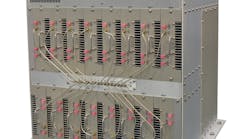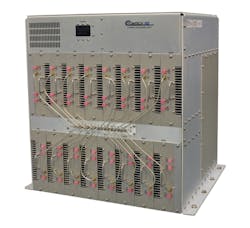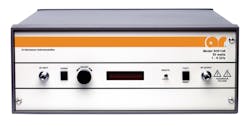Amplifier systems are usually designed to provide high levels of output power across RF and microwave frequencies, employing multiple stages of solid-state and/or vacuum-tube amplification. Larger amplifier systems require some form of cooling (e.g., forced-air cooling) to disperse the heat produced by the amplifying active devices, and typically incorporate some form of remote control interface for connection to a computer or control system. At the highest power levels, electron devices such as traveling-wave tubes (TWTs) are still commonly used. Nevertheless, some of the newer solid-state device technologies, including gallium-nitride (GaN) transistors, are gaining favor in high-power RF/microwave amplifier systems.
Related Articles
• Aria Develops Better Doherty Amplifier
• GaN-on-SiC Devices Fire Doherty Amplifiers
• Coaxial Amplifier Drives 26 To 40 GHz
For many years, a high-power RF/microwave amplifier involved the use of TWTs and other vacuum tubes to generate the output-power levels required for high-frequency signals—typically in communications and electronic-warfare (EW) transmitters. A TWT features three main components: an electron gun (to provide energy), a slow-wave structure (to control the exchange of energy for the high-frequency signal passing through the tube), and a collector (to receive the higher-energy RF/microwave signal).
The high-energy electron beam in a TWT’s electron gun is produced within the tube’s cathode, with an applied high voltage generating thermionic emissions of electrons. This cathode voltage is at an extremely high potential. A variety of different types of cathodes have been designed over the years, with many of these designs featuring extremely stable performance and very long operating lifetimes.
Traveling-wave-tube amplifiers (TWTAs) are still widespread throughout high-frequency applications, renowned for their high output levels and long-term reliability. For example, MCL, Inc., a MITEQ company, recently introduced its model MT2100 TWTA-based power amplifier for outdoor, airborne applications requiring at least 100 W broadband output power from 6 to 18 GHz. It is relatively compact for a high-power amplifier system (weighing just 25 lbs.) and is available with a variety of different cooling approaches, including conduction, forced-air, and liquid cooling.
Quarterwave Corp. offers a number of commercial-off-the-shelf (COTS) TWTAs suitable for military as well as commercial and industrial applications. As an example, the firm’s Series 2004 TWTAs operate from 8 to 12 GHz with pulsed output power levels to 10 kW at 8% pulse duty cycle and pulse widths from 0.05 to 50 μs. The amplifiers can produce minimum output levels of +70 dBm when fed with an input signal at 0 dBm. These amplifier systems, which use forced-air cooling, measure 36.5 x 23.5 x 30 in. and weigh 280 lbs. They are designed for operating temperatures from 0 to +50°C and altitudes to 10,000 ft. for airborne applications such as in pulsed radar transmitters.
Communications & Power Industries (CPI) has studied the performance of TWTs under different conditions and has developed its line of SuperLinear® TWTAs, nominally for efficient satellite-communications (satcom) applications. The firm has optimized the backoff operation of the amplifier circuitry around its TWTs to provide required output-power levels for different satcom systems while still meeting strict linearity and intermodulation requirements for those systems. The company claims that its amplifiers can achieve considerable savings in size and weight and as much as 70% reduction in prime power compared to traditional TWTAs used for the same satcom applications. The firm’s TWTAs are available for a number of different satcom operating frequencies, including at C-, X-, Ku-, and Ka-band frequencies.
The list of TWTA suppliers is still long, and includes such names as Amplifier Research (AR) RF/Microwave Instrumentation, Comtech Xicom Technology, CPI MPP, dB Control, DynamicWave, Instruments For Industry (IFI), L-3 Communications, Electron Technologies, Inc., Microwave Dynamics, Tesat-Spacekom, Thales Electron Devices, TMD Technologies Ltd., and Triton Electron Technology Division (ETD).
Solid-State Advantages
In spite of the high power levels and broad bandwidths of TWTAs, however, the efficiency of solid-state RF/microwave amplifiers has resulted in a much greater demand for this type of power amplifier solution in recent years. This has proven to be the case even though with the cooling requirements at high power levels, the sizes of these high-power solid-state amplifier systems are often comparable to the sizes of TWTAs at considerably higher power levels. Some of the newer solid-state power amplifier systems are making use of newer device technologies, such as GaN power transistors, for their active-device circuitry.
Related Articles
• Aria Develops Better Doherty Amplifier
• GaN-on-SiC Devices Fire Doherty Amplifiers
• Coaxial Amplifier Drives 26 To 40 GHz
As an example, model BPC318358-13000 from Comtech PST is very “tubelike” in terms of size and weight, in a package measuring 24.0 x 25.5 x 24.0 in. and weighing 230 lbs. But it is designed in a modular housing, with removable modules that simplify maintenance and upgrade operations. This S-band amplifier system (Fig. 1) operates from 3100 to 3500 MHz with 13 kW pulsed output power and 71-dB nominal RF gain. It is designed for signals having 2 to 200 μs pulse widths at 10% maximum duty cycle. The Class AB linear GaN amplifier system has better than -60 dBc spurious performance and runs on a 1.35-kVA supply. Designed for ground-based and laboratory applications, the amplifier system includes forced-air cooling and Ethernet remote control and can be enabled or disabled from active operation in less than 5 μs.
Empower RF recently unveiled its model 2141 solid-state Class AB linear amplifier based on GaN and LDMOS transistor technologies. It is suitable for CW signals and signals with modulation, such as AM and FM, over a range from 100 to 6000 MHz, with 500 W typical saturated output power to 1000 MHz and 125 W typical saturated output power to 6000 MHz. The four-unit stacked system measures 19 x 22 x 22 in. and weighs 220 lbs. It features a 20-dB gain-adjustment range, at least 47 dB power gain across the full frequency range, with better than ±2 dB gain flatness, and RS-422/485 remote control.
For broadband applications at lower power levels, numerous test-instrument manufacturers offer extremely linear amplifiers capable of covering broad bandwidths. The model GT-1020A instrumentation amplifier from Giga-tronics, for example, covers the broad frequency range from 100 MHz to 20 GHz, suitable for use with broadband signal generators, spectrum analyzers, and vector network analyzers. It provides about 600 mW (+28 dBm) output power from 100 MHz to 10 GHz and about 500 mW (+27 dBm) typical output power from 10 to 20 GHz, in a compact housing measuring 2.5 x 6.8 x 7.0 in. and weighing just 4.5 lbs with SMA connectors.
For both instrumentation and system use, Agilent Technologies offers its 83000A series of microwave system amplifiers for applications through 50 GHz. Some extremely broadband units are included, such as model 83006A, from 10 MHz to 26.5 GHz (20-dB gain and +13 dBm output power), and model 83051A, operating from 45 MHz to 50 GHz (23-dB gain at +12 dBm output power).
A company that supplies numerous power amplifiers for test applications, Instruments For Industry, has leveraged GaN device technology in its S61-50 series of broadband amplifiers, which provide as much as 50 W CW output power from1 to 6 GHz. The amplifiers are built into compact housings measuring just 5.25 x 19.00 x 24.00 in. They are well suited for electromagnetic-interference (EMI) compliance testing and electromagnetic-compatibility (EMC) testing requiring the wide bandwidth. The company also supplies power amplifiers that combine technologies, such as the ST181-50 series of amplifiers with as much as 50 W CW output power from 0.8 to 18.0 GHz, using TWTs and GaN transistors to achieve the final power levels.
Amplifier Research is another amplifier supplier well associated with solutions for test applications. Its recently introduced model 50S1G6 Class A power amplifier (Fig. 2) is supplied in a rack-mount case measuring 19.8 x 8.0 x 21.5 in. It delivers 50 W CW output power from 700 MHz to 6 GHz and 48-dB minimum gain with ±2 dB worst-case gain flatness. The amplifier includes an RF input leveling circuit to protect the amplifier from overdrive conditions by maintaining input levels at or below 0 dBm. It incorporates forced-air cooling and can be remote controlled by means of RS-232, GPIB, USB, and Ethernet interfaces.


